Reptile husbandry refers to the care and management of reptiles in a controlled environment, whether it’s for personal enjoyment, education, or breeding purposes. While reptiles have been popular pets for decades, their care requires an in-depth understanding of their natural behaviors, habitats, and physiological needs. Keeping reptiles healthy and thriving isn’t a task to be taken lightly, but with the right knowledge and resources, it can be a rewarding and fulfilling experience. In this article, we’ll explore the essential aspects of reptile husbandry to help you provide the best care for your scaly companions.
1. Understanding the Natural Habitat
One of the first steps in reptile husbandry is understanding where your pet comes from. Reptiles are incredibly diverse, with species ranging from desert-dwellers like bearded dragons to tropical creatures such as chameleons. Each species has its own unique habitat requirements, and replicating these conditions in captivity is essential to their well-being.
For instance, desert reptiles require high heat and low humidity, while tropical species need higher humidity levels and more consistent temperatures. It’s crucial to research the specific needs of your reptile to create an appropriate environment that mimics their natural habitat. This includes selecting the right type of substrate (such as sand, soil, or bark), providing proper heating and lighting (often through heat lamps and UVB bulbs), and ensuring access to water and appropriate food sources.
2. Proper Temperature and Lighting
Temperature and lighting are two of the most vital factors in reptile husbandry. Reptiles are ectothermics, meaning they rely on external sources of heat to regulate their body temperature. Without the proper heat, their metabolism, digestion, and immune systems can be compromised. Inadequate UVB lighting can also lead to deficiencies in calcium and other essential nutrients, causing serious health problems like metabolic bone disease.
To provide the correct temperature gradient, your reptile’s enclosure should include a basking area with temperatures ranging from 90°F to 100°F for many species, with cooler areas around 75°F to 80°F. A heat lamp or ceramic heat emitter is typically used to achieve this. It’s also important to monitor the enclosure’s temperature using a reliable thermometer to ensure it stays within the appropriate range.
UVB lighting is just as critical. Many reptiles, particularly those from tropical and subtropical environments, need exposure to UVB rays to synthesize vitamin D3, which helps them absorb calcium. Without proper UVB light, reptiles can suffer from serious health issues such as bone deformities and paralysis.
3. Diet and Nutrition
The diet of your reptile plays a significant role in its overall health and longevity. While some reptiles are herbivores, others are carnivores or omnivores. A balanced, species-specific diet is essential to prevent nutritional deficiencies and obesity.
For example, herbivorous reptiles such as iguanas thrive on a variety of fresh vegetables, while carnivorous reptiles like snakes and lizards feed on appropriately sized live or frozen prey. Omnivores, like bearded dragons, will eat a combination of insects, vegetables, and fruits. Each food type should be offered in the right proportions, and it’s crucial to ensure the food is nutrient-dense.
In addition to their primary diet, many reptiles require calcium and vitamin supplements to maintain their health. This is particularly important for species that are prone to metabolic bone disease, such as turtles and geckos. Offering calcium powder or other supplements on their food can help prevent such issues.
4. Enclosure Design and Enrichment
Reptiles are highly sensitive to their environment, and their enclosures should be designed to mimic their natural surroundings as closely as possible. An enclosure that’s too small, poorly ventilated, or lacking in proper hiding spaces can cause stress and lead to health problems.
The size and design of the enclosure depend on the species of reptile you own. Larger reptiles like iguanas need ample space to roam, while smaller species such as leopard geckos are content with more compact enclosures. Enclosures should be equipped with areas for basking, hiding, and climbing, if applicable. Incorporating live plants, branches, rocks, and other natural materials can help create a more stimulating environment.
Enrichment is another important factor in reptile husbandry. Providing objects like branches, caves, and hides will allow your reptile to feel secure and reduce stress. Additionally, offering opportunities for mental stimulation through foraging for food or problem-solving activities is a great way to prevent boredom, which can lead to behavioral issues and health problems.
Conclusion
Reptile husbandry is an intricate and rewarding practice that requires careful planning, observation, and adaptation to each reptile species’ needs. By understanding the importance of proper habitat, temperature, lighting, diet, and enrichment, reptile owners can create a healthy and fulfilling environment for their pets. It’s essential to continuously learn and adjust to your pet’s needs, as reptiles often live long lives and develop new behaviors over time. By mastering the art of reptile husbandry, you not only ensure your pet’s health but also build a deeper bond with these fascinating creatures.

